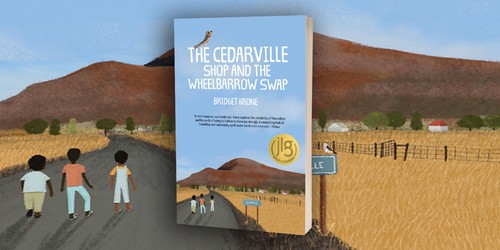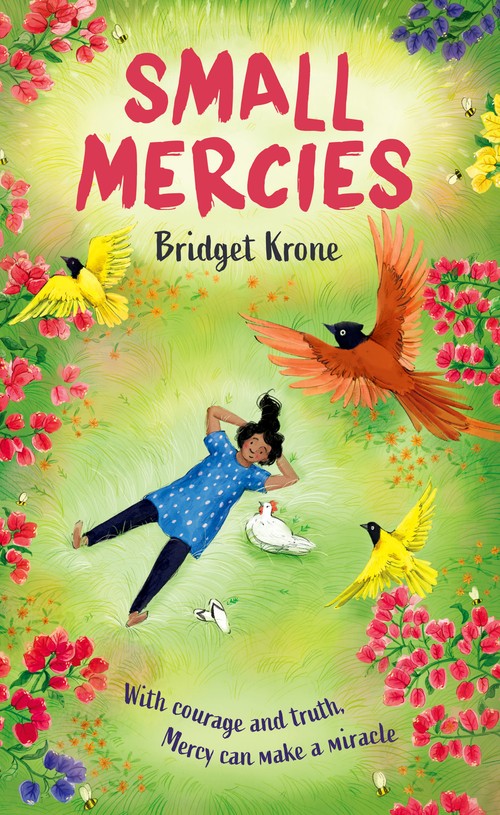
Kirkus ReviewSara CassidyKathi Appelt New York Journal of Books School Library Journal Q&A with Catalyst Press Review from Africa Access Review from Buffalo News (USA) Interview by Kathy Magrobie in The Witness
Kirkus Review
Set in post-apartheid Pietermaritzburg, South Africa, this realistic story traces protagonist Mercy’s quest to speak up for truth and, consequently, for herself.
Eleven-year-old Mercy has lived with her two elderly foster mothers—“Aunt Flora” and “Aunt Mary” McKnight—since she was orphaned at the age of 5. Although their home is filled with love, the McKnight sisters are so poor that they reuse tea bags as many as four to five times and most of the furniture has been sold. To make matters worse, Aunt Flora is slowly losing her memory to Alzheimer’s, and their beloved house seems to be falling apart just as a greedy housing developer is eying their property.
Painfully shy and reserved, Mercy struggles to cope with her school assignments and her complicated home life as she tries very hard not to stand out. When Mr. Singh moves into the McKnight house as a lodger, his stories about Gandhi’s peaceful struggle for independence inspire Mercy to stand up for herself. Krone’s characters are diverse, convincing, and full of life. The McKnight sisters are white, Mercy has dark skin and is likely of mixed heritage, Mr. Singh is Indian, and Mercy’s classmates are representative of South Africa’s diverse communities. The story stands on its own, but readers unfamiliar with South Africa might also benefit from concurrent research or discussion about South African history, cultures, and languages.
Sensitive, funny, and tender. (Fiction. 8-12)
Sara Cassidy
- Author of A Boy Named Queen
"Tender, exhilarating, and often hilarious, Small Mercies perfectly weaves the difficult and the wonderful truths of being alive. You will root for Mercy from the very first page, and she will be in your heart long after you've read this vivid, beautifully written novel.”
Kathi Appelt
- New York Times Bestseller, Newbery Honor Award, national Book Honor winner
“You will not leave the pages of this book without feeling somehow smarter and wiser and kinder. Why? Because Mercy’s story is one that makes space for our hearts to grow. Beautifully written, here’s an offering of love on the page.”
New York Journal of Books’
“Small Mercies isn’t intended to educate readers on details about South Africa as much as it’s intended for the reader to experience the multifaceted reality of South Africa.”
Mercy steals the reader’s heart from the very first page. Although more accurately, it’s Mercy’s eccentric foster aunts who do the initial stealing. Their quirky excuse notes—one says Mercy has “the collywobbles,” another that she has “a dicky tummy,” and on another that she can’t participate in inter-house cross-country because she “has a bone in her leg”—let the reader know some sweet humor is ahead.
Mercy needs that kind of protection. Orphaned at a young age under dark and confusing circumstances and now living with aunts so poor they can only afford one light bulb, the young girl carries with her a suitcase of fears and insecurities. All she does seem to have is the fierce love and protection of these two elderly relatives who will do anything for her.
Unfortunately, Aunt Flora is slipping into dementia, which is just one more thing for Mercy to worry about and feel insecure over. If the social worker from Child Welfare discovers just how poor the three are, they could take Mercy away. Added to all this is that the house seems to be falling apart around them just as a greedy housing developer starts putting pressure on the sisters to sell their property.
The story unwinds slowly and at first seems to be not much of a story. Mercy doesn’t want to dance a traditional dance, bring ethnic food to school, or be visible in any way in school. Even a simple assignment to write a report about someone she admires makes her anxious. She feels awkward around her classmates and doesn’t seem to have any friends. Even worse, a mean classmate frames Mercy for stealing money. Unfortunately, Mercy’s teacher isn’t a good fit for teaching, nor is she good at protecting her students. All of it makes Mercy a sad little character.
In spite of this, the story does unwind and takes the reader on an important journey in which Mercy finds courage. Along the way, readers are rewarded with bite-sized South African culture and history lessons beginning even before the first page. Krone prepares the reader with an explanation of the word “coloured,” and notes that in contrast to its use in America, “in South Africa its use is widespread and more acceptable, if sometimes controversial.” Mercy herself is coloured and her aunts are white, which adds to the complexity of the story in subtle ways.
Throughout the book, Krone casually includes references to various groups that are part of South Africa. No doubt for the typical South African reader, these references make perfect sense. Unfortunately, readers in North America, particularly the target reading age, will be clueless. Zulu? Xhosa? Voortrekker? For readers outside of South Africa, it would be nice to have even a paragraph or two about the different groups at the end of the book. In the end, though, it doesn’t matter. Small Mercies isn’t intended to educate readers on details about South Africa as much as it’s intended for the reader to experience the multifaceted reality of South Africa.
In fact, one of the benefits for the North American audience is that the reader realizes that, yes, there are unfamiliar differences between the two places, but even more important, the similarities are even greater. Take away the African cultures and replace them with familiar American cultures, and the classroom is the same. Children can be kind and can be cruel; they can stress out about school expectations; and the worries they have about their home life travel with them into the classroom.
Both South Africa and the United States have a history of cultural tensions and discrimination—another similarity. Krone could have taken this in many directions, but she chooses to focus on Mahatma Gandhi’s powerful response to discrimination as he traveled through South Africa, and how he lived the Sanskrit word satyagraha. Mercy learns that it doesn’t mean passive resistance, “but it’s actually two words joined together: satya, which means truth and agraha, which means polite insistence. So really it means the polite insistence of truth.” It’s just what Mercy needs to hear to find her own courage to stand up for herself. It’s also a weighty concept for young readers to be exposed to. If only there would be more satyagraha in the world today.
Karen Vermeulen’s simple line drawings complement Krone’s text with appropriate whimsy. The short chapters are a nice treat for the reading level, particularly since the themes have a depth to them that take some reflecting. Krone notes that her “favorite stories are those that, just when you expect a lesson, sing a song instead.” Small Mercies is just that surprising song, full of light and sweetness. Readers will carry the melody in their hearts long after the last page is turned.
School Library Journal
- Elizabeth Giles, Lubuto Library Partners, Zambia
In contemporary Pietermaritzburg, South Africa, Mercy Adams lives in fear of a social worker appearing at her doorstep and taking her away from Aunt Flora and Aunt Mary, the two elderly sisters who have been her foster mothers since she was very young.
To outsiders, she knows their life wouldn't be considered "normal"—Aunt Mary never hesitates to write Mercy absurd excuses to get out of her sixth grade responsibilities ("she has a bone in her leg," a cross country excuse reads), their ramshackle house is falling apart, and worst of all, Aunt Flora's memory has started to fade due to Alzheimer's.
When a housing developer makes aggressive attempts to buy their house, Aunt Mary declines the offer and instead takes in a lodger, Mr. Singh, to raise some extra money. Mr. Singh tells Mercy stories about his "friend," Mohandas (Gandhi), that teach her to appreciate the unforeseeable significance of small acts in building a better world.
Mercy is a winning protagonist who is by turns anxious, observant, and brave. South Africa is represented in its diversity: Mercy is mixed race, her aunts are white, and neighbors, classmates, and community members are from a range of racial and cultural backgrounds. Short, episodic chapters in the book's first half build to an emotionally compelling conclusion that is rich in insights about community, family, and social action.
VERDICT
This novel has a gentle, timeless feel, complex secondary characters, and quirky humor. A heartfelt, human, and wise addition to middle grade shelves.

